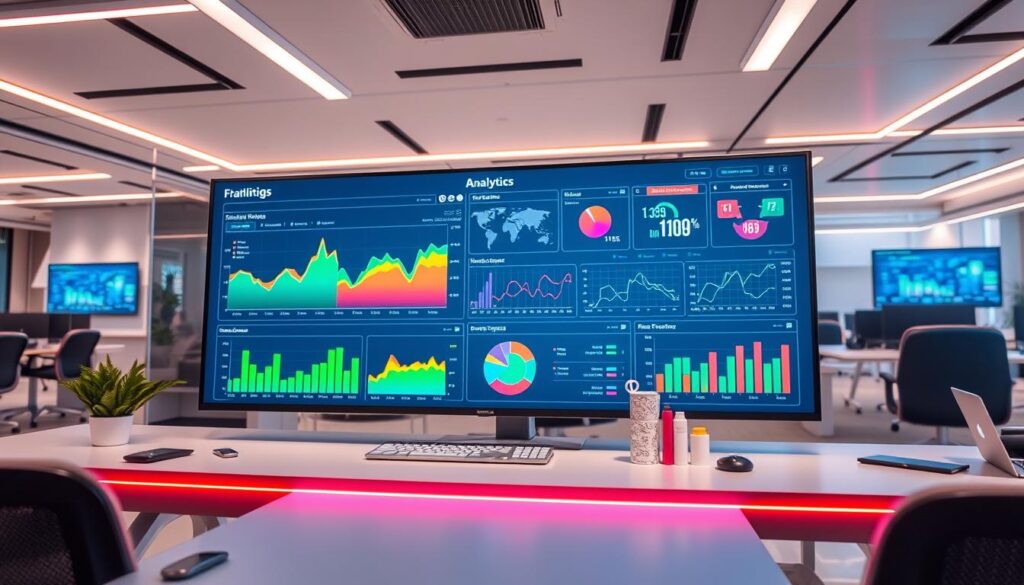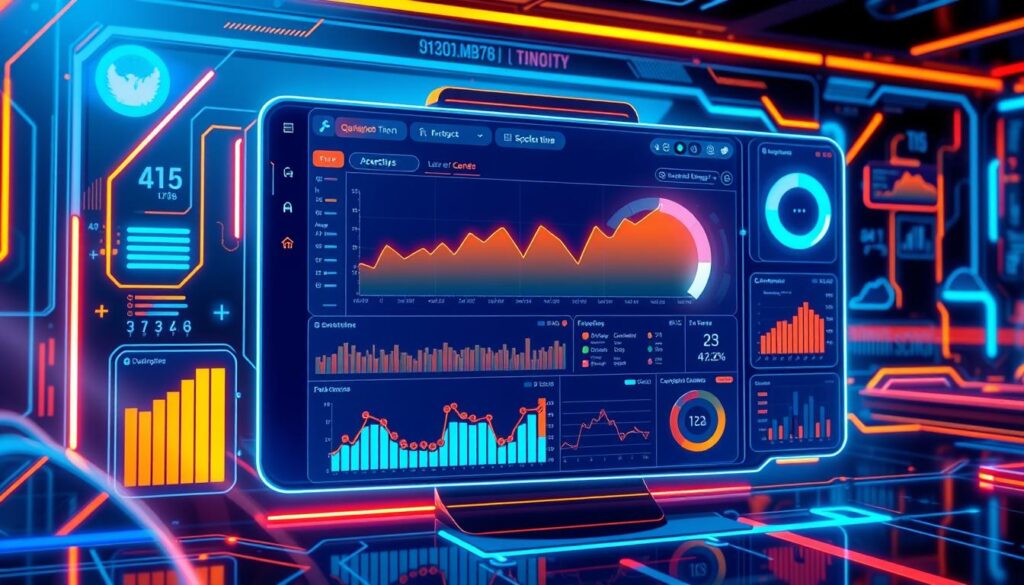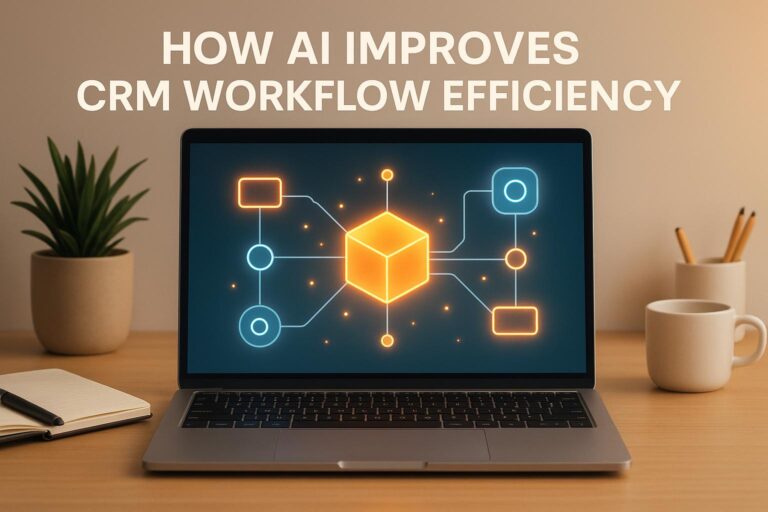Creating custom software interfaces and dashboards is a special skill. Glide Solutions and others excel in making these. They help use complex data for key decisions. This skill is part of UX design services needed in today’s web application development.
Building user-friendly interfaces takes a lot of work. They need smart design, strong functionality, and must work well together. These efforts lead to happier customers and more sales, from 2-7% more, says a study from McKinsey. Well-designed customized dashboards are essential for this success.
Custom software interfaces and dashboards do more than look good. They connect data with strategy, helping service providers see their full operation clearly.
Key Takeaways
- Custom interfaces help understand data better, aiding in smart choices.
- Professional UX design turns complex data into clear actions.
- Adding dashboards to services helps use data to engage clients better.
- Using dashboards well can significantly increase sales.
- For a competitive edge, it’s crucial to have user-friendly dashboard software.
- High-quality dashboards, like those from Glide Solutions, are vital for data-focused services.
- In today’s web development, good data visualization tools are critical.
Understanding Custom Software Interfaces
In today’s digital business world, custom software solutions are key for a company’s edge. Custom software interfaces make user interaction and data handling easier. They do this through software interface design meant for specific business activities.
Definition and Importance
Custom software interfaces are made to fit unique business and user needs. They’re not like standard software, which may need changes. These are built from scratch to include interactive dashboards and data visualization tools. They meet specific needs, boost efficiency, and positively impact profits.
Key Features of Custom Software Interfaces
These interfaces stand out for many reasons:
- Adaptability: They adjust easily to meet changing business needs.
- User-centric design: They aim for an easy and clear user experience.
- Integration capability: They fit well with existing systems, making things simpler.
- Scalability: They can expand with a business, avoiding the pitfalls of pre-made solutions.
Look at Amazon. They use custom interfaces in their inventory systems. This helps them handle lots of products and connect with customers worldwide. Their success shows the power of good custom software interface design.
Common Use Cases
Custom software interfaces are used in many areas:
- Healthcare: They help manage patient records and improve care with systems like Electronic Health Records (EHR).
- Retail: They streamline sales and boost customer experiences with platforms and POS systems made just for them.
- Banking and Finance: They improve security and user experience with custom trading and banking apps.
- Education: They make admin tasks and online learning easier with specific Learning Management Systems (LMS).
The design of custom software interfaces is key to industry success, innovation, and customer service. With an ongoing need for tailor-made solutions, the importance of custom interfaces in business will only increase. They are crucial for integrating effective data tools for immediate decision-making.
Benefits of Custom Dashboards
Today, businesses are turning to custom dashboards to make the most out of their data. These unique platforms help companies tap into their analytics more effectively. They give businesses a big edge in many key areas.
Enhanced Data Visualization
Custom dashboards use advanced tools to turn complex data into something simple and easy to grasp. Nowadays, 68% of businesses are putting more money into these technologies. This investment shows that clear visuals help process data faster, getting insights in less than a second.
This quick understanding lets people grasp large data sets fast. It helps them react to market changes better.
Tailored User Experience
These dashboards are designed with the user in mind. They highlight the most important stats and goals clearly. Their design not only pulls users in but also makes the dashboards simpler to use. This encourages more people to use them, making data handling better and more consistent across teams.
Improved Decision-Making
With real-time data, businesses can make quick, well-informed choices. This speed is essential for staying ahead in a fast-moving world. They gather data from all corners—marketing, sales, HR, IT—to create a united strategy. This teamwork leads to happier staff and smarter decisions.

Moreover, custom dashboards fit smoothly with the tools and systems businesses already use, like Spontivly. They’re not just nice to look at but they also offer a flexible way to work with data. They help companies grow and innovate for the long run.
Designing Effective Custom Interfaces
In the world of web apps, making user-friendly interfaces is key. Experts in design use special principles to make sure these interfaces are both pretty and useful. They focus on the users’ needs every step of the way.
User-Centered Design Principles
Keeping things simple and clear is vital for good dashboard design. Too much information can overwhelm people. So, a minimalist look isn’t just trendy; it’s a must for function.
This idea fits well with today’s UX design services. They aim to blend beauty with ease of use. Designers think about how we all process info to make interfaces that are straightforward and not tiring.
Prototyping and User Testing
Creating prototypes is a big part of web application development. This step lets teams try out designs before they decide. And user testing is key—it gives feedback on how real people use the app. This helps make the interface better and more enjoyable to use.
Find out the top dashboard design. They focus on user-first methods vital for today’s web and app projects.
| Feature | Impact on User Experience | Common User Feedback |
|---|---|---|
| Minimized Design | Reduces cognitive load | “Easier to find needed information fast.” |
| Interactive Elements | Enhances engagement | “Makes the application dynamic and fun to use.” |
| Customization Options | Users feel more in control | “I can adjust it based on my personal preferences.” |
| Clear Labeling | Improves navigation | “No confusion on what each part does.” |
These key ideas help build user-friendly interfaces as part of top-notch UX design services. Good design and thorough testing lead to functional and enjoyable-to-use interfaces in web application development projects.
Integrating Dashboards with Existing Systems
Integrating dashboards into current systems greatly improves how organizations work. It makes monitoring data and making decisions in real-time easy. By using powerful APIs, different software systems can connect smoothly. This ensures that data moves smoothly between them, supporting analytics and dynamic data sharing.
API Usage and Best Practices
For the best dashboard integration, it’s important to follow top API design practices. Use APIs that are secure, scalable, and well-documented. They should offer easy access to key business metrics. This is important for checking performance in different departments quickly. Using custom software, APIs let businesses add new tech solutions well. This leads to clear improvements in efficiency.

Ensuring Data Consistency
Keeping data consistent in integrated systems is key. This needs careful testing and planning. It includes picking the right tools that match well and are easy to use. Tests like integration testing and user acceptance testing are vital. It’s also critical to focus on security and plan for future growth.
Software integration is vital for smooth operations. It helps offer better customer service and make smarter decisions. So, a good dashboard integration can turn data into useful insights. This helps a business stay ahead in a competitive field.
Technology Stack for Development
The choice of a technology stack is key in web development and creating software. A good tech stack helps your software run well and grow. It affects how successful your software will be.
Popular Frameworks and Tools
Various tech stack parts do different jobs in making web apps and software. Let’s look at some important tech:
- Operating Systems: Main choices include Linux, iOS, and Android.
- Servers: Key servers like Apache and Nginx are important. They get help from AWS and Google Cloud for solid hosting.
- Programming Languages: Useful languages like JavaScript, Python, Ruby, and Java help with both backend and frontend work.
- Frontend and Backend Frameworks: React and Vue.js make the user interface better. Node.js and Django handle server tasks well.
- Data Management: Databases like PostgreSQL and MongoDB make storing and finding data easy.
Choosing the Right Technology for Your Needs
Picking the right technology should fit your project’s needs and goals:
| Stack Type | Components | Key Advantages |
|---|---|---|
| MEAN Stack | MongoDB, Express.js, Angular, Node.js | Uses one language across the stack, great for real-time apps. |
| MERN Stack | MongoDB, Express.js, React, Node.js | Helps make apps fast, focusing on good user interfaces. |
| .NET Stack | C#, .NET Core, F# | Perfect for needing strong, scalable, secure apps for business. |
| Ruby on Rails | Ruby, Rails Framework | Good for startups with quick development, easy growth, and lots of support. |
Choosing the best tech stack means better scalability, maintenance, and software performance. Whether it’s top user experiences or strong data use, the tech base is vital. Wise choices lead to efficient projects and great returns.
Future Trends in Custom Interfaces and Dashboards
The world of custom software interfaces and dashboards is changing quickly. AI and machine learning are leading the way. They make analytics smarter and data handling more efficient. In today’s fast world, these improvements are key. They allow for better predictions and make experiences more personal. This is changing how we understand data.
AI and Machine Learning Integration
Machine learning and AI are creating new kinds of dashboards. These dashboards learn from what users do to make their experience better. Imagine interfaces that connect directly with your brain. They’re looking into this future technology. AI helps turn difficult data into clear stories. This makes it easier for different parts of a company to use data.
The Role of Mobile and Cloud Technologies
In 2015, 37% of website visits came from phones. This shows how important mobile access has become. With faster 5G, mobiles will offer even better experiences. This includes amazing augmented reality visuals. So, making dashboards with a mobile-first approach is more important than ever.
Cloud technology is also crucial today. It offers flexible and powerful solutions. This tech lets you access data from anywhere, which is great for fast-moving companies. By combining it with edge computing, we get faster and more local insights. This improves how quickly and easily we can get information from dashboards.
FAQ
What are custom software interfaces and dashboards?
Custom software interfaces and dashboards are digital platforms made for businesses. They’re designed to meet specific needs. This makes user interfaces easy to use and data easy to understand.
Why is UX design important in custom software interfaces?
UX design makes sure custom software is not just efficient, but also easy and nice to use. Good UX design means users are happier, use the software more, and the software brings more benefits.
What defines a well-designed custom software interface?
A well-designed interface is easy to use, fast, and meets users’ needs. It makes navigating data simple with interactive tools. This turns complex data into something easy to work with.
What are the common use cases for custom software interfaces?
These interfaces are used for tracking business metrics, marketing efforts, employees’ data, and making reports. They also help make better business decisions.
How do customized dashboards benefit a business?
Customized dashboards show important metrics and KPIs clearly. They help businesses make smarter decisions, track performance better, and see trends and problems quickly.
What is involved in creating a tailored user experience with custom dashboards?
To create a tailored experience, you need to know what the user needs. Design dashboards that show important data first. Offer a personalized interface that boosts engagement and work efficiency.
How do user-centered design principles impact custom interface development?
These principles focus on what users really need and can do. Using them means the software will be easier to use and more helpful. This improves how users feel about and use the software.
What role does prototyping and user testing play in interface design?
Prototyping and testing let designers find and fix problems early. They help make the software better and easier to use before it’s fully built.
Why is API usage crucial in integrating dashboards with existing systems?
APIs let dashboards work smoothly with other systems. They ensure data is up-to-date and centralized. This makes dashboards more valuable and informative.
How does one ensure data consistency when integrating dashboard software?
To keep data consistent, use best practices in API and software integration. Have clear rules for data and check regularly. Use reliable methods to keep data accurate and trustworthy.
What should be considered when choosing a technology stack for developing custom software solutions?
Think about what the business needs, if the solution can grow, how easy it is to keep running, and if it works with other tech the business uses.
How will AI and machine learning impact the future of custom software interfaces?
AI and machine learning will make custom interfaces smarter. They’ll offer better predictions, personalize the experience, and automate tasks. This leads to smarter decisions and a more useful experience for users.
Why is mobile and cloud technology becoming essential in custom interfaces and dashboards?
They’re key because they offer flexibility and easy access to data anywhere. They’re also cost-effective and can grow with the business. Mobile and cloud technologies are now must-haves in modern software tools.



